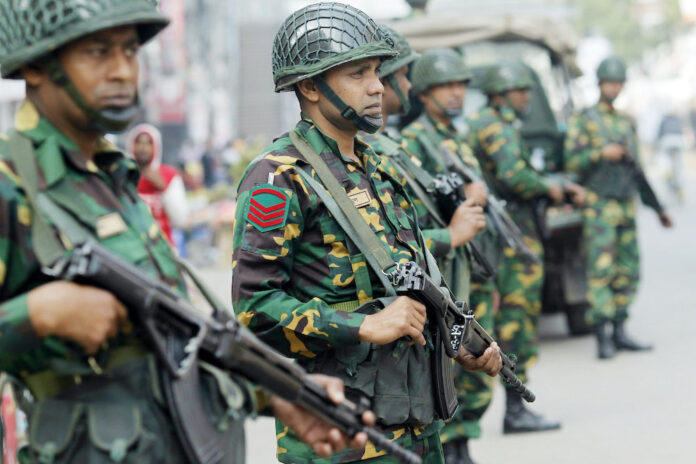Are we back to 1968, when student power briefly made an emergence, and subsided as those who exerted it developed paunches, and’— horror of horrors!— graduated into the real world? Actually, in Bangladesh recently, it was concern about the real world that led to the protests, and deaths, which brought down the government. However, there does not seem to be a student movement like the one which engulfed the world.
The Awami League could be seen as the beneficiary of the first movement, which led to the resignation of two Presidents, Charles de Gaulle of France and Ayub Khan of Pakistan. Though both were military men who had written their own constitutions and imposed them on their countries, only de Gaulle followed his, while Ayub ignored his. Handing over not to the National Assembly Speaker but the Commander-in-Chief, Gen Yahya Khan, who became President and CNLA. Prime Minister Hasina Wazed followed his example, ignoring the Constitution, and handing over to the Chief of Army Staff.
It could be that the current takeover in Bangladesh may be sort of a last hurrah for the military. Just as Pakistan is now safe from direct intervention, it seems possible that future Bangladeshi governments might be as sensible
That toppling of Auyb profited the Awami League, for Yahya then presided over the elections in which the Awami League made a clean sweep of all seats in East Pakistan, giving it a thin majority in the National Assembly, and then over the 1971 War, which led to the creation of Bangladesh, and which is remembered there as the War of National Liberation.
There is some irony in the fact that it was that War which was tangentially responsible for the fall of the Awami League government, because the protests were initially against the quota for the descendants of freedom fighters, which had been set at 30 percent, and was initially meant for freedom fighters. This was later extended to children in 1997 and grandchildren in 2010, as time went on and the fighter and then their children became ineligible. At this rate, great-grandchildren would also be made eligible anytime soon. This was resented by the large number of those who were not the descendants of freedom fighters, but who hoped for government jobs. It must be noted that while Bangladesh has made impressive economic progress, it has not created enough jobs to keep pace with the number of entrants into the job market. It is a severe indictment of an economy where young people are willing to die rather than cease their protests.
The Supreme Court finally ruled that the quota of five percent for freedom fighter’s descendants was sufficient. However, the protests resumed after a pause, this time asking the government to go, as well as action to be taken against those who ordered the killings This led to another shooting of protesters, and the Army told the Prime Minister to resign.
It could be seen as a refusal by the Army to maintain in government a party that had so lost the trust of the people that they were ready to risk their lives in opposition. There was apparently no built-in obedience to the government, because it seems the military did not like being used as thr ultimate sanction by the government.
It is worth noting that there was no initiating of the takeover. Previously, in Bangladeshm when the military took over, there was blood shed. Political leaders were replaced by heirs, so it seems pointless. In 1977, the military took over when there was use of the military against the government. It was as if the military realized that Bhutto’s rule relied on their killing people. They took overr, and the killing stopped. Similarly,in Bangladesh, the killing has stopped.
There has been a distancing of the Army from rule. In Pakistan, 1977 was the last time that the COAS designated himself CMLA. In 1999, Gen Pervez Musharraf designated himself Chief Executive. In Bangladesh, this time the COAS has not even taken over the reins of government, but inducted a government of advisers headed by Dr Muhammad Younas, Bangladesh’s only Nobel Peace Prize laureate. However, it is only logical, and previous examples of similar governments of advisers have shown, the Army assumes a leading position.
Perhaps the entire region needs to be concerned, and at least the governments. Bangladesh has become the second SAARC member in two years where the government has had to feel after mass protests. Only in 2022, President Gotobaya Rajapakse and his brother Mahinda, the Prime Minister, had to resign and flee abroad. Sri Lanka had suffered a default, and though Bangladesh did not suffer one, she had still obtained a $4.7 billion package in January last year, meaning that the country, despite its economic successes, found that it was having foreign exchange difficulties.
In fact, no country is as badly off as Pakistan, which went to the brink of default last year, and barely staved off. Even though it has agreed as harsh an IMF programme as any, it is still not out of the woods, and still runs the risk of default. However, the danger has receded far enough for the Prime Minister not to fear having to do a moonlight flit anytime soon.
However, while the power tariff may have the potential to generate protests, so does joblessness. Pakistan is not the only country feeling pressure on the job creation front from a young population, which is throwing an increasing number of jobseekers into the market every year, without the economy growing strongly enough to accommodate them. Bangladesh grew in 2023, the latest year for which the World Nak had data, at 5.8 percent. India grew at 7.6 percent, Pakistan at 0.0 percent. The job problem is thus explosive across the region.
This does not just apply to South Asia. Neighbouring Myanmar is also facing a democratic crisis of its own, which is at the root of its anti-Rohingya drive. Bangladesh has also got to bear the burden of hosting the Rohingya. While Pakistan spent the last quarter or so of the 20th ce4ury hosting the world’s largest population of refugees in the shape of the Afghans, now it is Bangladesh that hots the world’s largest refugee population in the shaper of the Rohingya. Though they my not compete directly with the Bangladeshi youth, they too are placing pressure on the overall job market. One of the effects of the coup has been to reduce Awami League influence. The Awami League has a stronger position as the founding party of Bangladesh than the Muslim League had as the founding party of Pakistan at the parallel stage, back in 1997. One reason is Bangladesh itself; the loss of half the country was harmful to the PML too. (Military rulers in Pakistan have been fascinated by the PML name and have adopted it, but Bangladesh’s military rulers have left it alone.)
The Awami League is being surrounded by its enemies. One of the first acts of the military government was to release Begum Khaleda Zia, whom the League thought imprisoned for the rest of her life. Then it handed over the government to Dr Younas, whom the Sh Hasina detested as a potential challenger. The saga is likely to go on. Both Sheikh Hasina and Begum Khaleda have sons who are being brought forward. Indeed, even before Begum Khaleda’s son Tarique completes his takeover of the BNP, his daughter is being looked at with attention.
One consequence is that Bangladesh’s pronounced tilt towards India is no longer certain.
It could be that the current takeover in Bangladesh may be sort of a last hurrah for the military. Just as Pakistan is now safe from direct intervention, it seems possible that future Bangladeshi governments might be as sensible.























